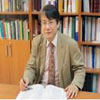Q1: Please tell us about your past research and future plans using Park Systems AFM.
As my research field is related to chemistry, I usually use AFM to evaluate the nano-structure and characteristics of materials. For the last 20 years, I have been using 4~-5 different kinds of AFMS to do experiments, and since I joined the University of Junju in 2007, I have been using versatile Park Systems equipments for my teams’ experiments.The reason why I chose Park’s AFM is that it is designed in a way easily accessible to students and yet also carries a variety of useful functions. Currently, we are utilizing Park’s AFMs to analyze carbon nano-tubes and nano-particles, and also to dissect and assess the characteristics of the nano-structures various compound materials.
Q2: What kind of help is Park AFM giving you throughout your research? In what respect did the AFM give you the most satisfaction?
My current field of research, nano-material engineering, focuses on developing new compound materials that will facilitate the growth of next-generation industry.
Typically, they are related to electronics industries such as semi-conductors and displays-one of the standout industries in Korea. In order to advance and continue our development in these fields, we need to develop a variety of new electronics materials to evaluate. Park AFM played a major role when it came to evaluating samples of newly developed creations. AFM (Atomic Force Microscopy), captures the structure of a material as expected of microscopes in general, however it is one of the very few types of microscopy that can also evaluate the a material’s characteristics. This is the reason why I prefer to use AFM, especially Park’s, because my research requires me to observe the structure of new materials while simultaneously evaluating specific traits of interest.
Q3: In what field or subject would Park Systems’s AFM be more effective?
AFM is a tool with greater capabilities than those of basic microscopes.There have been 30~40 kinds of related technology that have been developed since the invention of AFM in 1986. Throughout these technological developments, AFM stands out by not only measuring material structure but also evaluating key properties, such as, electrical or magnetic behavior, at the same time.
Currently, one of the most important components of an AFM is the piezo stage apart on which samples are placed to allow the AFM probe to approach and image them. This component is crucial for accurate analysis and high resolution imaging. Park uses the best piezo stage technology currently available. As a result, their AFM systems are not only highly accurate for structural analysis but very effective in characterizing both electrical and magnetic properties.





